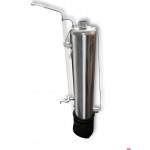
How to Protect Yourself from Botulism When Canning
Botulism is a serious illness that occurs when consuming food containing botulinum toxin. This bacterium develops when meat, fish, mushrooms, or other food items are improperly or inadequately heat-treated. The best method for preventing botulism when canning is using an autoclave.
Home canning and botulism are interconnected. Botulinum toxin enters food through improper canning practices and develops there. The characteristic symptoms include:
- Abdominal cramps, bloating, nausea, vomiting;
- Deterioration of vision, seeing spots, reduced tongue mobility, swallowing difficulties;
- Chest pain, shortness of breath, lack of air, hoarse voice, limb cramps.
The most dangerous consequence of botulism development without timely treatment is death. Even a small spore of the toxin entering the body can quickly develop and become a threat to health and life.
There are two types of botulism pathogens
- Spore. It has a shell that protects the dormant botulinum toxin. It is resistant to low temperatures and saline solutions. It dies at temperatures of 100 °C, with the optimal being 115 °C for several hours of cooking.
- Vegetative. Under favorable conditions and in the absence of oxygen, it develops and begins to reproduce actively. Toxic substances are released, which die at temperatures of 80 °C.
Home canning of food cannot provide such high temperatures. If the temperature is insufficient, the bacterium will not die and will start to grow in the jar.
The bacterium does not die from drying, smoking, salting, or freezing food. Spores can survive in food for many years.
Botulinum toxin can be found in soil, the bodies of pets, dried meat or fish, and home canned goods.
Important rules for disease prevention:
- Follow hygiene standards when preparing food. Wash your hands and all ingredients of the dish.
- Do not consume canned goods that have expired.
- Do not use canned goods with a bulging lid or that are deformed.
- Do not eat canned goods that show signs of mold or that have spoiled.
- Do not can fish, meat, or mushrooms at home without an autoclave.
- Vaccination against botulinum toxin if you are at risk (working in laboratory research, going on long hiking trips).
Eliminating botulism in conventional canning methods is difficult. It is safest to can vegetables and fruits. They are the least prone to contamination but also require adherence to hygiene standards: sterilizing jars and lids, washing food products, and using vinegar, salt, or sugar as preservatives.
Before canning mushrooms, they should be boiled for about half an hour. This way, you won’t have to fear botulism. Simple boiling of mushrooms is not sufficient to neutralize botulinum bacteria. They can survive even at +120°C.
The safest method to eliminate botulism in home canning is to use an autoclave. It operates under a different system, at high temperatures and pressures.
Reasons to use an autoclave for canning:
- 100% protection against botulism. You can can any products in autoclaves, including fish, meat, and mushrooms. If bacteria are present, they will die within a minimal cooking time. Autoclaves operate at temperatures above 120 °C, which guarantees the destruction of any pathogenic organisms in food;
- Ability to use gas or electric devices, depending on needs;
- A huge selection of sizes and volumes of autoclaves. You can can from 5 to 300 jars at a time;
- Safe industrial use of autoclaves;
- Long service life; some models are purchased once for a lifetime;
- The technology allows you to convert an autoclave into a distillation apparatus.
To be confident in the safety of homemade canned goods made from fish, meat, and mushrooms, we recommend buying a household autoclave. This device will assist in the annual routine of preparing food for winter, save time, and significantly simplify the process. Moreover, canned goods from an autoclave are completely safe and do not contain botulinum toxin, making them ready for consumption even by children.
Also, read:
- Operating Modes of Autoclaves
- What is an Autoclave
- Hydraulic Testing of Autoclaves
- How to Use an Autoclave
- How to Choose an Autoclave









